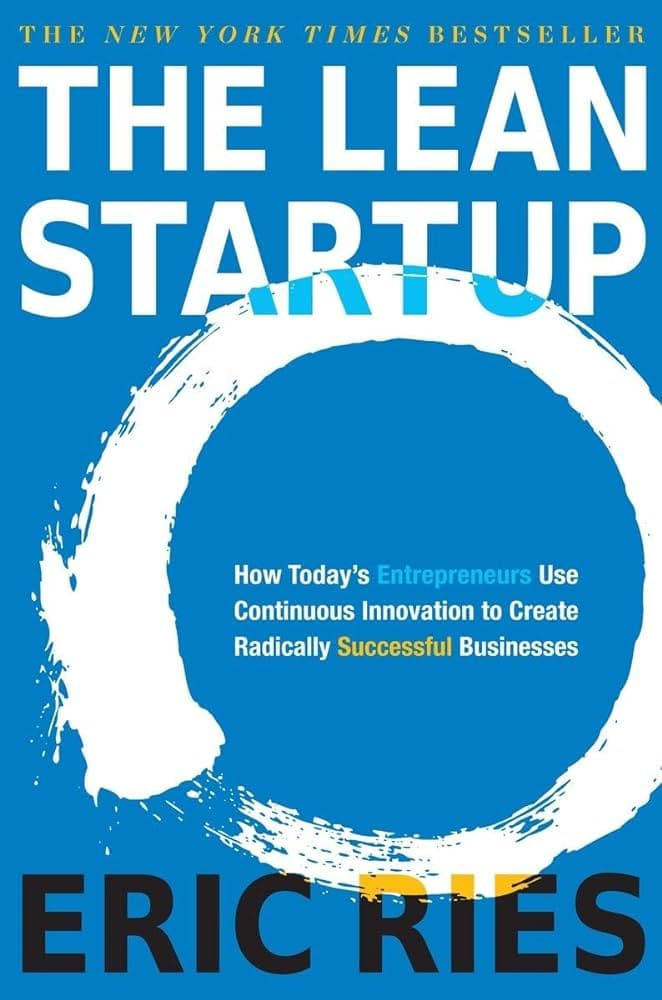The Lean Startup - Summary and review

🚀 Summary: The Lean Startup in 30 seconds

Contents
What is The Lean Startup about
The Lean Startup is a world-wide known book, especially famous in the startup community, written by the American entrepreneur and blogger Eric Ries. In this summary we go in to the concept of lean thinking, how Ries is applying it to startups, with the highlights and frameworks that constitute the process of building a Lean startup! 🚀
What is Lean thinking?
Lean thinking is a framework that provides a new way of thinking about organizing human activities to deliver more value while eliminating waste. The term was coined by Womack and Jones when they studied the Toyota Production System. Lean thinking aims to create a lean culture that embraces sustainable growth that is centered around the customer and employee being aligned and satisfied. A lean organization should educate all individuals to maximize value and identify opportunities to reduce waste. Well, a great framework for large traditional companies with physical products and production lines that are in a rather stable state. But with the Lean Startup, Ries takes the Lean methodology one step further and tries to apply it to startups.
A short summary of The Lean Startup
THE FIVE PRINCIPLES OF THE LEAN STARTUP
Eric Ries describes the five principles of the Lean Startup as:
Entrepreneurs are everywhere: You don’t have to work in a garage to be an entrepreneur, there are intrapreneurs at large companies, etc.
Entrepreneurship is management: A startup is an institution, not just a product, so it requires management.
Validated learning: Startups exist not to make money, create products, or serve customers. They exist to learn how to build a sustainable business, which can be done scientifically through running experiments to test each part of our vision.
Innovation accounting: To improve the outcome of entrepreneurship and hold entrepreneurs accountable - focus on how to measure progress, set milestones, and prioritize work by deploying innovation accounting.
Build-Measure-Learn: The fundamental process of a startup is to turn ideas into products, measure customers’ responses, and learn whether to pivot or persevere. Accelerating this feedback loop is essential.
Measuring the right things with “innovation accounting”
Instead of optimizing we should focus on learning. Tools for product improvement for large companies do not work in the same manner for startups. A startup might be building the wrong thing, and therefore has to focus on achieving learning first of all. As optimization of marketing or product won’t yield any result if you are focusing on the wrong market or building something nobody wants or needs.
VANITY METRICS ARE SO YESTERDAY… SAY HELLO TO THE NEW KID ON THE BLOCK - ACTIONABLE METRICS
Metrics often are focusing on what investors or people want to hear, not to measure what kind of learning takes place - such metrics are referred to as vanity metrics. Innovation accounting is a framework that focuses on achieving learning through actionable metrics. These metrics should demonstrate clear cause and effect. Only then can true learning take place within the organization as human beings are better at learning from their actions when they are given a clear and objective assessment. Actionable metrics should have the following three A’s:
Actionable
Accessible
Auditable
Some practical methods suggested are A/B testing or split testing.
The engines of growth - understand and find your focus
The two most important assumptions entrepreneurs make are what Eric Ries calls the value hypothesis and the growth hypothesis. For the growth hypothesis one must ask himself where growth will come from - which could be any of the following:
Word of mouth
As a side effect of product usage
Through funded advertising
Through repeat purchase or use
Eric goes on to explain the three engines of growth, where startups should try to align their efforts on one, in order to stay focused on a relatively small set of metrics:
The Sticky Engine of Growth: Products with high customer retention rate, with an expectation that new customers will continue using the products. These companies need to monitor their churn rate carefully, since the rate of growth is simply the natural growth rate - churn rate.
The Viral Engine of Growth: Products where awareness spreads rapidly between persons, similar to how a virus becomes an epidemic. Customers are not intentionally acting as evangelists. Growth rather happens automatically as a side effect of customers using the product. Just like covid - viruses are not optional. The viral loop (feedback loop) powers the viral engine and its speed is determined by the viral coefficient which measures how many new customers will use the product as a consequence of onboarding one new customer. The higher this viral coefficient, the faster the product spreads. These companies need to obsessively focus on the viral coefficient, because tiny changes in this number cause dramatic changes in future growth. Thus, many viral products are free to use with extremely low frictions to signup, but rather rely on indirect revenue streams like advertising.
The Paid Engine of Growth: Products where new customers are acquired through paid channels - usually through advertising. These companies can increase the rate of growth either by lowering the cost of acquisition (CAC) or increase revenue from each customer (LTV).
Technically several engines of growth can operate in a business at a time, but Ries suggests to focusing on one.
Not being afraid to challenge your vision or idea
Build the wrong thing is not inherently bad. But, building the wrong thing and not realizing it is pretty much the worst thing you could do, since it means you are building something nobody wants or needs. Thus, it won’t help you how much you optimize or market this product - you will have a tough time succeeding.Instead, if you are iterating through the Build-Measure-Learn loop, getting customer feedback, and deploying innovation accounting to make sure you are measuring the right things and not just staring at vanity metrics, you will be in a much better position.
“If you cannot fail, you cannot learn.”
Achieving validated learning and not being afraid to fail is absolutely essential to a company. I like how Eric Ries constantly pushes this mantra - you should not be afraid to challenge your vision and ask yourself “should this product be built?“. It is easy getting caught up in alot of technicalities or details - but, to me, taking a step back and answering these questions is powerful - helping you to stay focused and build real value.
Lean thinking applied to tech startups - far-fetched?
The Lean Startup is an absolute classic, that most entrepreneurs, founders, and startup people have either read or heard alot about. So what is the fuzz about? Well, this book was on my reading list for these exact reasons and being very well-reviewed with a 4.1 on GoodReads, and it didn’t disappoint, well sort of…
Now having finished it, maybe it was a bit overhyped. With a background with a B.Sc. in Industrial Engineering and Management I have had lean thinking bashed into my skull for years. So I was no stranger to the world of Lean methodology, but applying this rather scientific approach and framework to startups in “extreme uncertainty” as Ries explains it, is really not as straightforward.
To me, alot of the methodologies, advice and tips in the book are great to apply and be reminded of when building a company.
But sometimes the advice seem rather trivial and the connection to Lean thinking is a bit far-fetched.Obviously, a startup needs to put the customer first, focus on what customers want and is benefited from, eliminate unnecessary activities and have extremely fast cycle times. I am not just sure the innovation accounting and Build-Measure-Learn are truly scientific methods as such and really always possible to apply in the world of “extreme uncertainty” that startups live in. Sometimes the “just-do-it” approach it is the only option available, well to be honest a lot of the time.. To me, starting a company is just as much a craft as a science. But we can definitely always push for minimizing uncertainty where possible.
Buy the book: The Lean Startup 👇
If curious in more, you can buy the full book on Amazon: Print | KindleFrequently asked questions (FAQs)
Q: Who is Eric Ries?
Andrew Chen, VC @ Andreessen Horowitz. Led growth team at Uber 2015-2018.
Want to learn more about growing SaaS companies?

